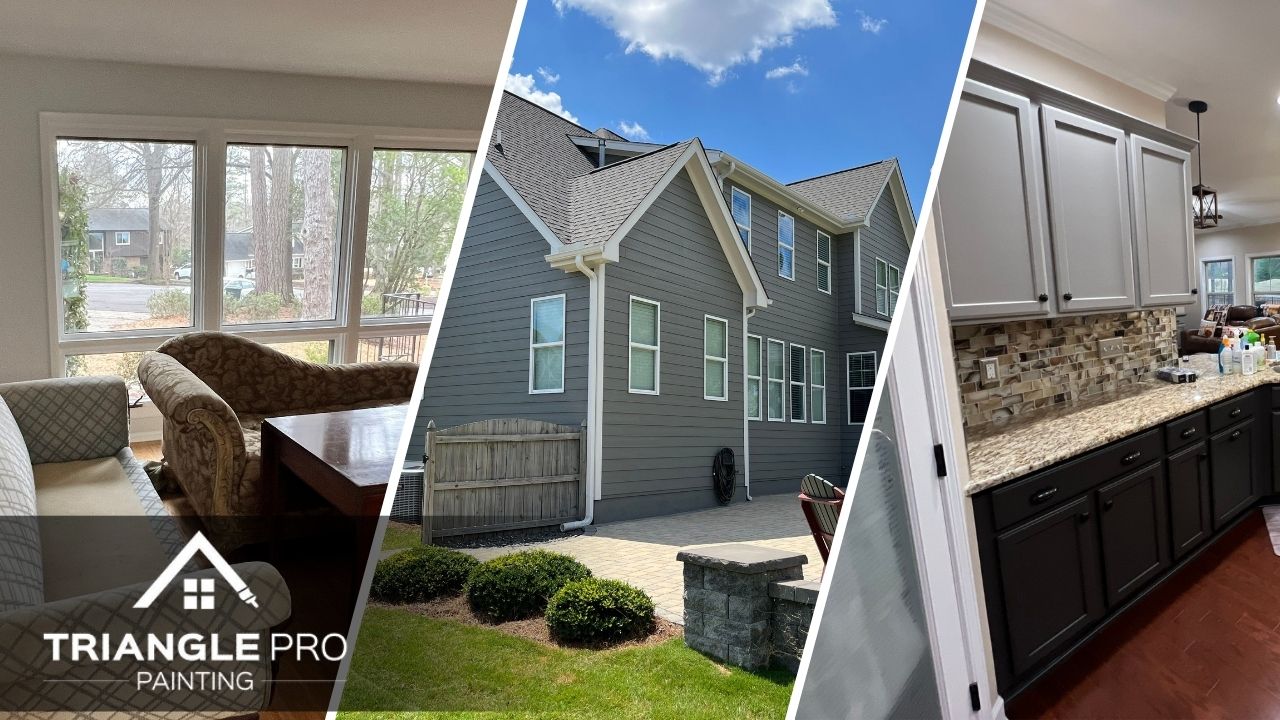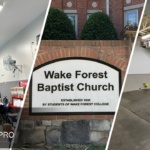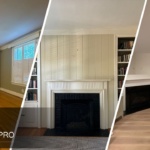Raleigh homeowners face a unique set of challenges when it comes to maintaining their property’s exterior. The distinctive North Carolina Piedmont climate—characterized by humid summers, mild winters, and frequent precipitation throughout the year—creates specific conditions that can significantly impact your home’s paint job. While general painting guidelines suggest repainting every 5-10 years, Raleigh’s microclimate necessitates a more nuanced approach. As local exterior painting specialists serving the Triangle area for over a decade, we’ve observed firsthand how our regional weather patterns affect paint longevity and performance. This comprehensive guide will help you understand the optimal repainting timeline for your Raleigh home, factoring in our specific climate variables, your home’s construction materials, and the latest advances in paint technology.
Understanding Raleigh’s Climate Impact on Paint Durability
Raleigh’s climate sits at an interesting crossroads that creates distinct challenges for exterior paint. Our region experiences approximately 43 inches of rainfall annually, distributed relatively evenly throughout the year, coupled with humidity levels that regularly exceed 70% during summer months. This persistent moisture creates ideal conditions for mildew and algae growth on painted surfaces, particularly on north-facing walls that receive less direct sunlight. Additionally, our summer temperatures frequently surpass 90°F for extended periods, causing paint to expand and contract dramatically as surfaces heat during the day and cool at night. This thermal cycling accelerates paint breakdown, especially on south and west-facing walls that receive intense afternoon sun exposure.
Unlike the salt air concerns of coastal North Carolina homes, Raleigh’s inland position spares us from salt-related paint deterioration. However, our region’s abundant tree cover introduces different complications. Pollen from our magnificent oaks, pines, and other native trees creates a yellowish film on exterior surfaces each spring, which can become embedded in paint over time if not properly cleaned. Additionally, the tannins from tree debris can cause discoloration when they remain in contact with painted surfaces—a particular concern for homes in wooded lots throughout North Durham, Northwest Raleigh, and Cary’s established neighborhoods.
The Seasonal Painting Calendar for Raleigh Homes
Timing your repainting project optimally within Raleigh’s seasonal patterns can significantly extend your paint job’s lifespan. While conventional wisdom suggests spring as ideal painting weather, Raleigh’s abundant spring pollen creates serious challenges for fresh paint application. Microscopic pollen particles can become embedded in wet paint, compromising both appearance and adhesion. Instead, experienced Raleigh painters typically recommend the “sweet spots” of late September through early November or mid-April to early May (after the heaviest pollen has subsided). These periods typically offer the moderate temperatures (ideally 50-85°F) and lower humidity levels that allow paint to cure properly.
Winter painting in Raleigh, while possible during mild periods, introduces risks as latex paints require minimum temperatures of 35-40°F even with modern cold-weather formulations. Our occasional winter freezes can prevent proper curing if they occur within 48 hours of application. Conversely, painting during Raleigh’s peak summer months (late June through August) presents different challenges—extreme heat and humidity can cause paint to dry too quickly on the surface while remaining uncured beneath, leading to bubbling and adhesion failures. Professional painters often adjust their working hours during summer to paint east and south-facing walls in the afternoon when they’re shaded, and west-facing surfaces in the morning before direct sun exposure.
Material-Specific Repainting Guidelines for Raleigh Homes
The construction materials of your Raleigh home significantly influence optimal repainting schedules. Traditional wood siding, common in historic neighborhoods like Oakwood, Hayes Barton, and Cameron Park, typically requires repainting every 3-5 years in Raleigh’s climate. Wood absorbs moisture readily during our humid months and expands and contracts significantly with our temperature fluctuations, causing paint to crack and peel more quickly than on other substrates. Fiber cement siding (like HardiePlank), increasingly popular in newer developments throughout North Raleigh, Apex, and Holly Springs, generally maintains its paint job for 7-10 years due to its dimensional stability and moisture resistance.
Brick homes, abundant throughout the Triangle area, present special considerations. While properly painted brick can retain its finish for 15-20 years, the initial decision to paint brick is essentially permanent, as removal is extremely difficult. For homes with painted brick exteriors, particularly those in older areas like Five Points or Inside-the-Beltline neighborhoods, touch-ups may be needed every 5-7 years, with comprehensive repainting typically necessary after 12-15 years in Raleigh’s climate. Stucco homes, less common but present in certain neighborhoods with Mediterranean-inspired architecture, typically need repainting every 5-7 years, as our humidity levels can contribute to hairline cracking that compromises paint adhesion.
Paint Quality and Technology: Impact on Raleigh Repainting Cycles
The quality and technology of your paint dramatically affect how often Raleigh homeowners need to repaint. Recent advances have produced formulations specifically engineered for southeastern climates like ours. High-quality acrylic latex paints with added mildewcides have proven particularly effective in Raleigh’s humid conditions, often extending repainting intervals by 2-3 years compared to standard formulations. These premium paints typically contain higher percentages of titanium dioxide and acrylic resins that provide superior coverage, color retention, and resistance to our specific environmental challenges.
Self-priming paints, while convenient, generally don’t perform as well in Raleigh’s climate as separate primer-paint systems, particularly on problematic surfaces like weathered wood or previously peeling areas. The additional investment in dedicated primers containing higher resin concentrations significantly improves adhesion during our seasonal temperature fluctuations. For homes near Raleigh’s many lakes, creeks, and wetland areas where humidity levels remain consistently high, elastomeric coatings—though considerably more expensive—can extend painting intervals to 10-12 years due to their superior waterproofing properties and ability to stretch without cracking during seasonal expansion and contraction.
Warning Signs: When Raleigh Homes Need Repainting Regardless of Timeline
Beyond calendar-based schedules, certain visible indicators signal when Raleigh homes need repainting regardless of elapsed time. Peeling paint, particularly on south-facing surfaces, indicates failure of the paint system to accommodate our dramatic seasonal temperature differentials. Noticeable fading—especially of red, blue, and yellow pigments that degrade more quickly in our strong UV exposure—suggests breakdown of the paint’s protective capabilities. Chalking (a powdery residue when touched) indicates the paint binder is breaking down under Raleigh’s environmental stressors.
Persistent mildew issues, particularly on north-facing walls that dry slowly after our frequent rains, suggest the current paint’s mildewcide has been depleted. Homes in heavily wooded areas of Raleigh, like those near Umstead Park, the Neuse River Greenway, or Lake Johnson, may exhibit accelerated algae growth that compromises both aesthetics and protection. Wood rot around trim, windows, or door frames indicates water is penetrating the paint barrier, allowing our persistent humidity to damage the substrate—a particular concern for older homes in established Raleigh neighborhoods where original wood trim remains common.
Proactive Maintenance to Extend Paint Life in Raleigh
Between complete repainting projects, proactive maintenance can significantly extend your paint’s lifespan in our challenging climate. Annual gentle pressure washing (below 1500 PSI) removes accumulated pollen, mildew, and environmental contaminants before they can permanently bond with or degrade the paint surface. This practice is particularly valuable for north-facing walls that receive limited sun exposure and retain moisture longer after our frequent summer thunderstorms. For homes in heavily wooded areas common throughout North Raleigh, regular removal of organic debris from roof lines and gutters prevents tannin-rich materials from staining painted surfaces during heavy rains.
Selective touch-up painting of vulnerable areas—particularly south and west-facing trim pieces that receive maximum UV exposure—can extend whole-house repainting intervals by 1-3 years. Wood surfaces require special attention in our climate; applying a clear water repellent to the bottom edges of wood siding and trim annually helps prevent moisture wicking that leads to premature paint failure. Additionally, maintaining proper drainage away from your home’s foundation helps prevent the excess ground moisture that contributes to higher humidity levels around lower portions of the house—a particular concern in the many Raleigh neighborhoods built on clay soils that retain water.
Professional Assessment vs. DIY Evaluation
While this guide provides general timelines for Raleigh’s climate, every home exists in its own microclimate created by surrounding trees, proximity to water features, elevation, and property orientation. Professional painters with specific experience in the Triangle area can provide custom assessment services that analyze your home’s unique exposure factors and material conditions. These evaluations typically cost between $150-300 but can save thousands by identifying specific vulnerabilities before they develop into major issues requiring extensive repairs.
DIY-inclined homeowners can perform basic assessments by examining their home each spring after pressure washing. The “chalk test” (running a dark cloth over light-colored paint to check for powder residue) helps identify UV breakdown, while the “tape test” (applying and removing painter’s tape to check paint adhesion) can reveal areas where our humidity and temperature cycles have compromised bonding. Pay particular attention to south-facing surfaces and areas where different materials meet, as these transition points often fail first in our variable climate conditions. Remember that Raleigh’s abundant tree canopy can create significantly different exposure conditions on different sides of the same home, necessitating customized maintenance approaches rather than one-size-fits-all solutions.
The Raleigh-Specific Repainting Timeline
Based on our extensive experience serving homeowners throughout the Triangle region, we recommend the following climate-adjusted repainting intervals for Raleigh homes: Wood siding requires attention every 4-6 years, adjusting toward the shorter end for older homes in established neighborhoods with mature landscaping that increases moisture retention near the structure. Fiber cement siding typically performs well for 7-10 years before requiring repainting in our climate. Brick homes with previously painted surfaces generally need comprehensive repainting every 12-15 years, though touch-ups at the 7-year mark help maintain appearance and protection. Trim elements, regardless of main siding material, generally need attention every 4-5 years due to their vulnerability and critical waterproofing function.
Triangle Pro Painting understands the unique challenges Raleigh homeowners face in preserving their homes’ beauty and structural integrity against our distinctive climate patterns. Our locally-developed techniques and material selections specifically address the humidity, temperature fluctuations, and environmental factors that affect paint performance in the Triangle area. By following these Raleigh-specific guidelines and partnering with experienced local professionals, you can maintain your home’s exterior efficiently and effectively, maximizing both protection and curb appeal despite our challenging Mid-Atlantic climate conditions.











